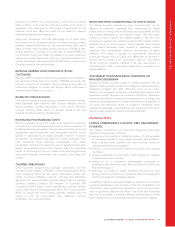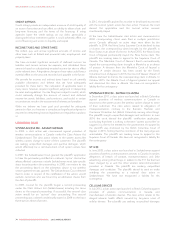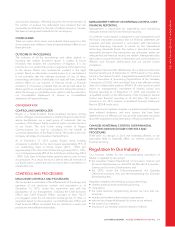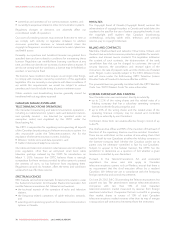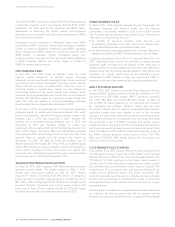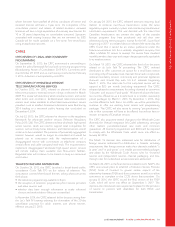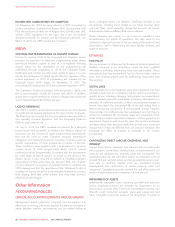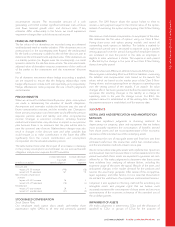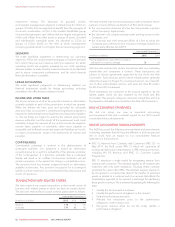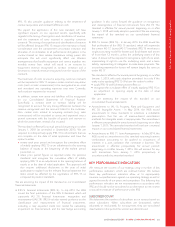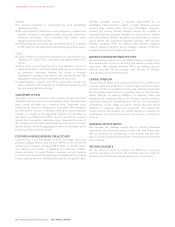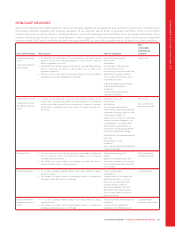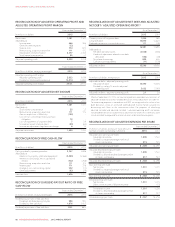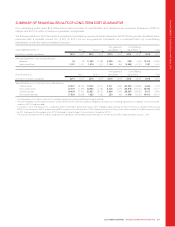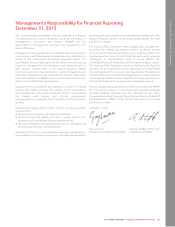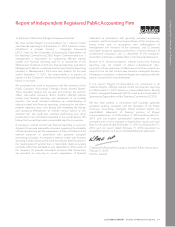Rogers 2015 Annual Report Download - page 83
Download and view the complete annual report
Please find page 83 of the 2015 Rogers annual report below. You can navigate through the pages in the report by either clicking on the pages listed below, or by using the keyword search tool below to find specific information within the annual report.
MANAGEMENT’S DISCUSSION AND ANALYSIS
circumstances warrant. The recoverable amount of a cash
generating unit (CGU) involves significant estimates such as future
cash flows, terminal growth rates, and discount rates. If key
estimates differ unfavourably in the future, we could experience
impairment charges that could decrease net income.
FINANCIAL INSTRUMENTS
The fair values of our derivatives are recorded using an estimated
credit-adjusted mark-to-market valuation. If the derivatives are in an
asset position (i.e. the counterparty owes Rogers), the credit spread
for the bank counterparty is added to the risk-free discount rate to
determine the estimated credit-adjusted value. If the derivatives are
in a liability position (i.e. Rogers owes the counterparty), our credit
spread is added to the risk-free discount rate. The estimated credit-
adjusted value of derivatives requires assessment of the credit risk
of the parties to the instruments and the instruments’ discount
rates.
For all derivative instruments where hedge accounting is applied,
we are required to ensure that the hedging relationships meet
hedge effectiveness criteria both retrospectively and prospectively.
Hedge effectiveness testing requires the use of both judgments
and estimates.
PENSION BENEFITS
When we account for defined benefit pension plans, assumptions
are made in determining the valuation of benefit obligations.
Assumptions and estimates include the discount rate, the rate of
future compensation increase, and the mortality rate. Changes to
these primary assumptions and estimates would affect the pension
expense, pension asset and liability, and other comprehensive
income. Changes in economic conditions, including financial
markets and interest rates, may also have an impact on our pension
plan because there is no assurance that the plan will be able to
earn the assumed rate of return. Market-driven changes may also
result in changes in the discount rates and other variables that
could require us to make contributions in the future that differ
significantly from the current contributions and assumptions
incorporated into the actuarial valuation process.
The table below shows what the impact of an increase or decrease
in the primary assumptions and estimates on our accrued benefit
obligation and pension expense for 2015 would be:
(In millions of dollars)
Increase (decrease)
in accrued
benefit obligation
Increase (decrease)
in pension
expense
Discount rate
Impact of 0.5% increase (146) (18)
Impact of 0.5% decrease 167 19
Rate of future compensation
increase
Impact of 0.25% increase 18 3
Impact of 0.25% decrease (18) (3)
Mortality rate
Impact of 1 year increase 39 4
Impact of 1 year decrease (41) (4)
STOCK-BASED COMPENSATION
Stock Option Plans
Our employee stock option plans attach cash-settled share
appreciation rights (SARs) to all new and previously granted
options. The SAR feature allows the option holder to elect to
receive a cash payment equal to the intrinsic value of the option,
instead of exercising the option and acquiring Class B Non-Voting
shares.
We measure stock-based compensation to employees at fair value.
We determine the fair value of options using our Class B Non-
Voting share price and option pricing models, and record all
outstanding stock options as liabilities. The liability is marked to
market each period and is amortized to expense using a graded
vesting approach over the period during which employee services
are rendered, or over the period to the date an employee is
eligible to retire, whichever is shorter. The expense in each period
is affected by the change in the price of our Class B Non-Voting
shares during the period.
Restricted share unit (RSU) and deferred share unit (DSU) plans
We recognize outstanding RSUs and DSUs as liabilities, measuring
the liabilities and compensation costs based on the awards’ fair
values, which are based on the market price of the Class B Non-
Voting shares, and recognizing them as charges to operating costs
over the vesting period of the awards. If an award’s fair value
changes after it has been granted and before the exercise date, we
recognize the resulting changes in the liability as a charge to
operating costs in the year the change occurs. For RSUs, the
payment amount is established as of the vesting date. For DSUs,
the payment amount is established as of the exercise date.
JUDGMENTS
USEFUL LIVES AND DEPRECIATION AND AMORTIZATION
METHODS
We make significant judgments in choosing methods for
depreciating our property, plant and equipment that we believe
most accurately represent the consumption of benefits derived
from those assets and are most representative of the economic
substance of the intended use of the underlying assets.
We amortize the cost of intangible assets with finite lives over their
estimated useful lives. We review their useful lives, residual values,
and the amortization methods at least once a year.
We do not amortize intangible assets with indefinite lives (spectrum
and broadcast licences) because there is no foreseeable limit to the
period over which these assets are expected to generate net cash
inflows for us. We make judgments to determine that these assets
have indefinite lives, analyzing all relevant factors, including the
expected usage of the asset, the typical lifecycle of the asset, and
anticipated changes in the market demand for the products and
services the asset helps generate. After review of the competitive,
legal, regulatory, and other factors, it is our view that these factors
do not limit the useful lives of our spectrum and broadcast licences.
Judgment is also applied in choosing methods for amortizing our
intangible assets and program rights that we believe most
accurately represent the consumption of those assets and are most
representative of the economic substance of the intended use of
the underlying assets.
IMPAIRMENT OF ASSETS
We make judgments in determining CGUs and the allocation of
goodwill to CGUs or groups of CGUs for the purpose of
2015 ANNUAL REPORT ROGERS COMMUNICATIONS INC. 81




